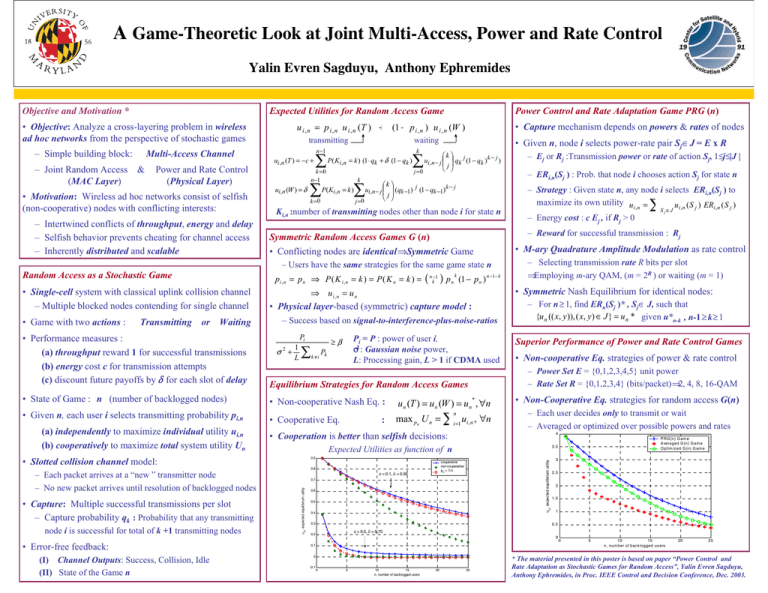A Game-Theoretic Look at Joint Multi-Access, Power and Rate Control
advertisement

A Game-Theoretic Look at Joint Multi-Access, Power and Rate Control
Yalin Evren Sagduyu, Anthony Ephremides
Objective and Motivation *
Expected Utilities for Random Access Game
u i , n = p i , n u i , n (T ) + (1 − p i , n ) u i , n (W )
• Objective: Analyze a cross-layering problem in wireless
ad hoc networks from the perspective of stochastic games
– Simple building block:
– Joint Random Access
(MAC Layer)
Multi-Access Channel
&
Power and Rate Control
(Physical Layer)
• Motivation: Wireless ad hoc networks consist of selfish
(non-cooperative) nodes with conflicting interests:
– Intertwined conflicts of throughput, energy and delay
– Selfish behavior prevents cheating for channel access
– Inherently distributed and scalable
Power Control and Rate Adaptation Game PRG (n)
transmitting
n −1
ui , n (T ) = −c +
∑ P( K
k
i, n = k ) (1 ⋅ qk + δ (1 − qk )
k =0
n−1
ui,n (W ) = δ
∑ P(K
∑
j =0
k
∑
i, n = k )
k =0
• Capture mechanism depends on powers & rates of nodes
• Given n, node i selects power-rate pair Sj∈J = E x R
waiting
j =0
⎛k ⎞
ui , n − j ⎜⎜ ⎟⎟ qk j (1 − qk ) k − j )
⎝ j⎠
⎛k ⎞
ui, n− j ⎜⎜ ⎟⎟ (qk −1) j (1 − qk −1) k − j
⎝ j⎠
Ki,n :number of transmitting nodes other than node i for state n
pi ,n = p n ⇒ P ( K i ,n = k ) = P ( K n = k ) =
• Single-cell system with classical uplink collision channel
– Multiple blocked nodes contending for single channel
• Game with two actions :
Transmitting
or Waiting
⇒
( ) pn
n −1
k
k
(1 − p n )
Pi
Equilibrium Strategies for Random Access Games
• Non-cooperative Nash Eq. :
• Given n, each user i selects transmitting probability pi,n
• Cooperative Eq.
∑
Pi = P : power of user i,
σ2 : Gaussian noise power,
L: Processing gain, L > 1 if CDMA used
≥β
k ≠i
Pk
:
*
max pn U n = ∑i =1 ui ,n , ∀n
n
• Error-free feedback:
(I) Channel Outputs: Success, Collision, Idle
(II) State of the Game n
– For n ≥ 1, find ERn(Sj )* , Sj∈ J, such that
{u n (( x, y )), ( x, y ) ∈ J } = u n * given u*n-k , n-1 ≥ k ≥ 1
Superior Performance of Power and Rate Control Games
• Non-cooperative Eq. strategies of power & rate control
• Non-Cooperative Eq. strategies for random access G(n)
– Each user decides only to transmit or wait
– Averaged or optimized over possible powers and rates
4
u , expected equilibrium utility
0.9
cooperative
non-cooperative
p = 1/n
n
c = 0.1, δ = 0.95
0.7
0.6
n
0.5
0.4
0.3
3
2.5
2
1.5
1
0.5
c = 0.5, δ = 0.75
0.2
0
0.1
0
-0.1
P RG (n) G am e
A veraged G (n) G am e
O ptim iz ed G (n) G am e
3.5
Expected Utilities as function of n
un, expected equilibrium utility
node i is successful for total of k +1 transmitting nodes
S j ∈J
– Power Set E = {0,1,2,3,4,5} unit power
– Rate Set R = {0,1,2,3,4} (bits/packet) ⇒2, 4, 8, 16-QAM
un (T ) = un (W ) = un , ∀n
0.8
• Capture: Multiple successful transmissions per slot
– Capture probability qk : Probability that any transmitting
∑
– Selecting transmission rate R bits per slot
⇒Employing m-ary QAM, (m = 2R ) or waiting (m = 1)
• Cooperation is better than selfish decisions:
• Slotted collision channel model:
– Each packet arrives at a “new ” transmitter node
– No new packet arrives until resolution of backlogged nodes
– Energy cost : c Ej , if Rj > 0
• Symmetric Nash Equilibrium for identical nodes:
• State of Game : n (number of backlogged nodes)
(a) independently to maximize individual utility ui,n
(b) cooperatively to maximize total system utility Un
n −1− k
u i ,n = u n
• Performance measures :
(a) throughput reward 1 for successful transmissions
(b) energy cost c for transmission attempts
(c) discount future payoffs by δ for each slot of delay
1
σ +
L
– Strategy : Given state n, any node i selects ERi,n(Sj ) to
maximize its own utility ui ,n =
u i , n ( S j ) ERi , n ( S j )
• M-ary Quadrature Amplitude Modulation as rate control
• Physical layer-based (symmetric) capture model :
– Success based on signal-to-interference-plus-noise-ratios
2
– ERi,n(Sj ) : Prob. that node i chooses action Sj for state n
– Reward for successful transmission : Rj
Symmetric Random Access Games G (n)
• Conflicting nodes are identical ⇒Symmetric Game
– Users have the same strategies for the same game state n
Random Access as a Stochastic Game
– Ej or Rj :Transmission power or rate of action Sj, 1≤j≤|J |
0
5
10
15
n, number of backlogged users
20
25
0
5
10
15
n, num ber of bac k logged us ers
20
25
* The material presented in this poster is based on paper “Power Control and
Rate Adaptation as Stochastic Games for Random Access”, Yalin Evren Sagduyu,
Anthony Ephremides, in Proc. IEEE Control and Decision Conference, Dec. 2003.






